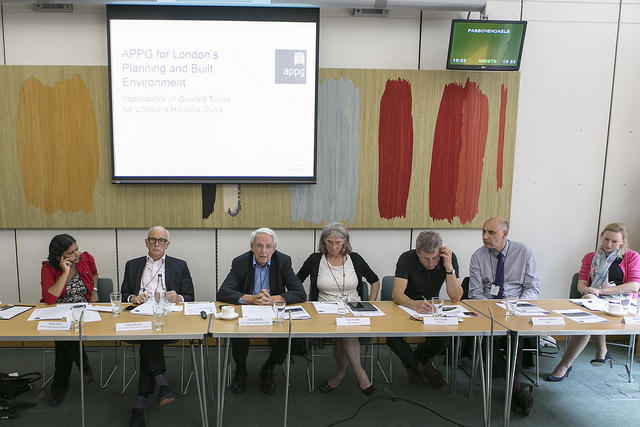Post
APPG REPORT - Social Housing After Grenfell
20 Jul 2017
[caption id="attachment_2119" align="alignright" width="640"] photo ©Agnese Sanvito[/caption]
The All Parliamentary Group for London’s Planning and Built Environment gathered in Portcullis House last week to hear a panel of experts on the implications of Grenfell Tower for London’s housing stock.
The session was introduced by Rupa Huq, MP for Ealing Central and Acton, and NLA chairman, Peter Murray, who said it was important to learn from events and ensure that the right mechanisms are in place so similar disasters do not happen again.
[The minutes of the meeting can be downloaded here]
Sam Webb, principal at Sam Webb Chartered Architect, was involved in the fallout from the Ronan Point collapse in 1968 as an expert witness for the families involved. Webb said he believed ruptured gas mains were burning in the Grenfell Tower fire, that nobody did a fire risk assessment, and the panels beneath the windows burned through in four and a half minutes. Inside, wooden surfaces were painted with 10 coats of oil-based paint. After Ronan Point, Webb sent representations to the Home Office for changes to be made to blocks of flats he visited across the country, fearing that similar problems might ensue, but was met with little interest, the government saying that if they enacted part 3 of the Fire Precautions act it would make far too many people homeless.
‘They have known about this for a long time’, said Webb. Sue Foster, strategic director of neighbourhoods and growth at Lambeth Council said that four weeks on from the ‘terrible disaster’ of Grenfell there had been significant activity, some clarity, but an awful lot of uncertainty remains. It was unlikely that there would be a single point of failure, she said, but clearly there had been a focus on the cladding. One block in Lambeth has already had to be reclad, and the authority is doing ‘quite intrusive’ fire risk assessments over the next two weeks. ‘It is really important I can give reassurance to residents that they are and will remain safe’, she said.
[caption id="attachment_2118" align="alignleft" width="640"] ©Agnese Sanvito[/caption]
More work is being done on water sprinklers as part of a solution, but tenant management issues, in particular, need ‘revisiting’. Finally, building regulations will have to be ‘fundamentally’ reviewed, as well as how they are administered; communication with residents is absolutely crucial; and local authorities need to pool resources to provide emergency responses but need resources from central government to do so.
One of the key problems, said Pat Hayes, managing director of Be First, LB Barking and Dagenham and former executive director of regeneration and housing at Ealing Council, is that building regulations are too ‘layered’ and need a fundamental review. They must be updated to reflect modern technology, methods of construction and ways of living, with the need to look at the efficiency of fire compartmentation strategies when ‘60s buildings are adapted. The other big issue was of the ‘intermediate landlord’ often putting in less fire-resistant doors, for example, and for approved fire plans without inspection of what is produced.
Despite the huge pressure for housing stock, we must also ensure the quality and safety of new high density homes is not compromised, but it should be remembered that more people die from fires in street properties than in towers, said Hayes. Adrian Dobson, executive director of members, RIBA, said the inquiry into the Grenfell Tower fire must concentrate not just on the cause of the fire, but also the wider systemic and regulatory context. Responsibility was another factor - the onsite clerk of works used to be the independent overseer of construction and workmanship on behalf of the client, but this role has all but disappeared today. In the 1970s more than half of practising architects were employed in the public sector – today that is down to just 6%. ‘So have we lost some expertise within our housing delivery bodies?’ he asked.
Finally, Sarah Davies, head of project management at Pocket Living said that building regulations treat new build, change of use and refurbishment in residential quite differently, with the first two inspected to comply with modern regulations but the last only required to ensure that the situation is no worse than existing. Building control thus often feels unable to intervene on some schemes where it feels strongly. Davies also suggested that London in the long term may wish to consider ensuring there is surplus capacity to house people immediately affected by similar incidents in the future.
Discussion of the issues from the audience included questions over the suitability of the housing provided for those affected by Grenfell; the paucity of affordable housing that is available; ‘stay put’ and sprinkler polices during incidents; the issue of ‘fire engineering’ schemes through planning and whether ‘investment housing’ could be used in what is a ‘national emergency.’ ‘It isn’t a tragedy, it’s an atrocity’, said Webb, ‘and it is being directed at poor people’.
To download the minutes of the meeting click here.
To join the mailing list to receive information about subsequent meetings, click here.

